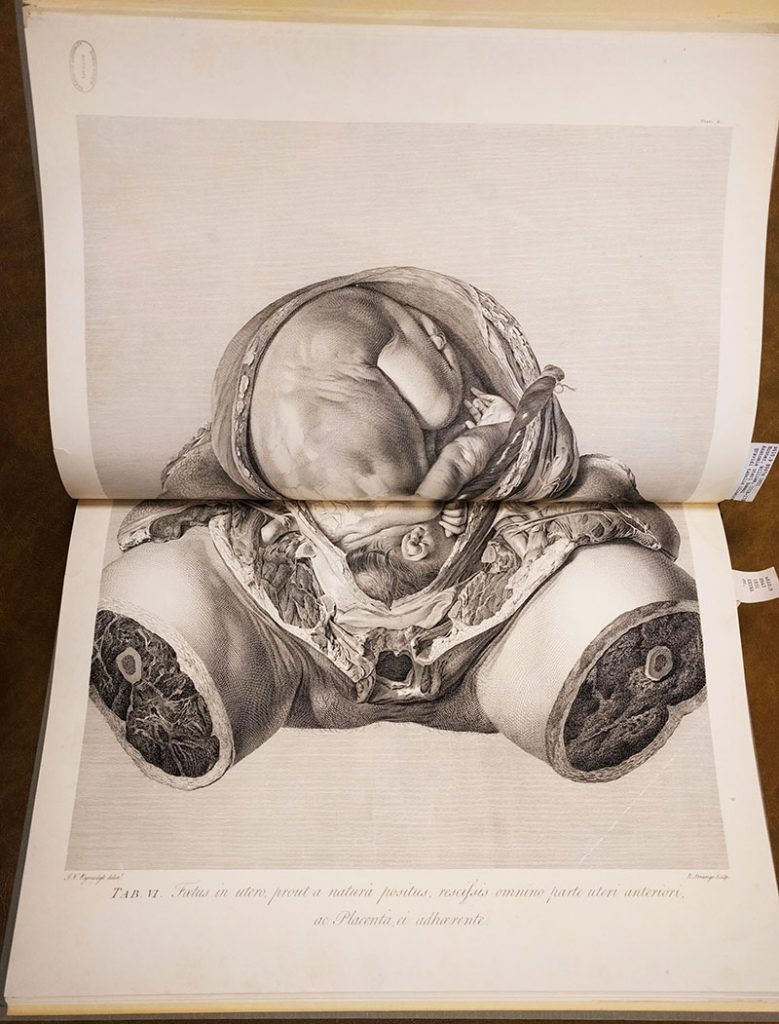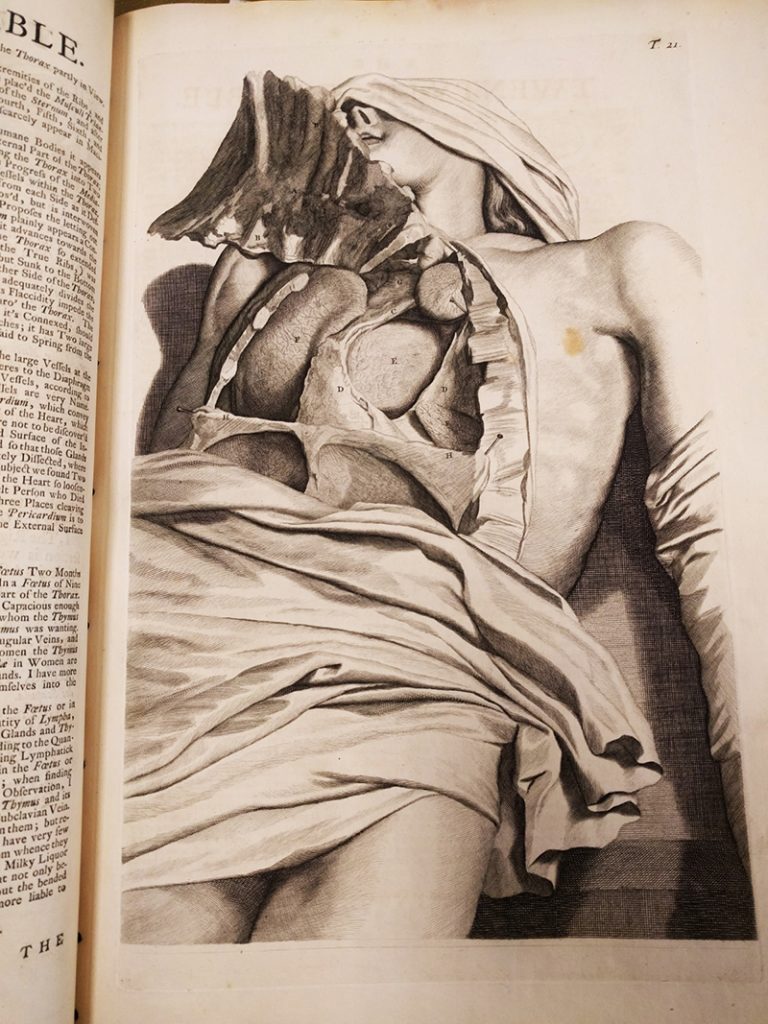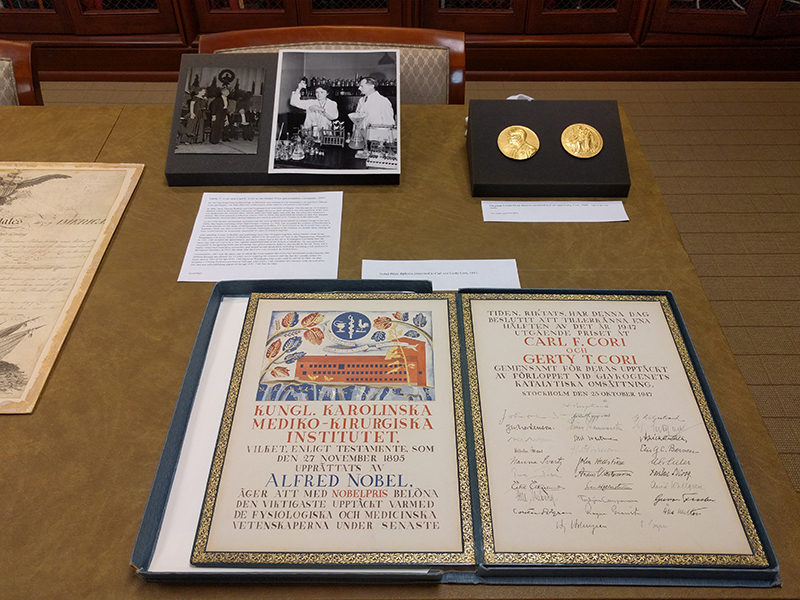In 1999, Dr. Cynthia Wichelman, an associate professor of emergency medicine at Washington University in St. Louis, launched the Mini-Medical School with the goal of educating the community by sharing the expertise of the medical faculty. Over the past 20 years, it has become so popular that it has expanded to include three different series (Mini-Medical School I, II, and III) which are each offered twice a year.
Each Mini-Medical School consists of eight two-hour evening courses covering a wide spectrum of medicine. Additionally, Mini-Medical School students are offered the opportunity to attend an extra, hour-long session in the Archives and Rare Books Reading Room. In this session, Becker Library staff members feature highlights from our rare book and archival collections to give students an overview of medical history as well as some of the School of Medicine’s significant contributions to modern medicine. Here’s a look at some of the books and archival material we displayed for one of the Mini-Medical School’s recent visits.

Becker Library has three copies of Vesalius’ magnum opus, but only one first edition! This work represents a major advance in the study of anatomy over the Greek physician Galen (129-c.210 CE), whose writings had long been the standard anatomical curriculum for European medical students despite the fact that Galen had never actually dissected a human body. In his quest to depict human anatomy with perfect accuracy, Vesalius commissioned an unfortunately uncredited artist to create the over 200 stunning woodcut illustrations in the Fabrica. As you can see in the image above, Vesalius took great pains to string up the cadavers into lifelike poses, and his artist depicted them in natural Italian landscapes. Though he remains uncredited, art historians have theorized that the Flemish artist Jan Stephan van Calcar (1499-1546) was responsible for illustrating some of the figures.

William Hunter (1718-1783) was a Scottish anatomist and obstetrician who was especially interested in the human gravid (pregnant) uterus. Though earlier anatomical depictions of pregnancy did exist, they were very rare and were drawn based on observations of living bodies. Even Vesalius, who is illustrated dissecting a female cadaver in the frontispiece of the Fabrica, depicted the vagina as an inverted penis. The first edition of Hunter’s work was illustrated with copperplate engravings by Jan van Rymsdyk (1730-1790) and was published in 1774. The illustrations in the book proceed in reverse chronological order, from nine months to five weeks gestation.

We brought out this work by the English surgeon and anatomist William Cowper (c. 1666-1709) and showed it alongside Dutch physician Govard Bidloo’s (1649-1713) “Anatomia humani corporis” as an example of 18th-century plagiarism. Govard Bidloo originally published his Anatomia in 1685, with over 100 illustrations drawn by Gérard de Lairesse (1640-1711) and engraved by Abraham Blooteling (1640-1690). The plates were later sold to William Cowper, who used them in his own anatomical atlas without crediting Bidloo or Lairesse except in the introduction to his text. The two anatomists were contemporaries, and an outraged Bidloo petitioned the Royal Society to revoke Cowper’s membership due to his plagiarism. However, Cowper had legally purchased the plates from Bidloo’s publisher, and he faced some criticism but no repercussions.
William Beaumont (1785-1853) spent the majority of his medical career as a U.S. Army surgeon. When he was stationed at Fort Macinack in Michigan, he treated a French Canadian man named Alexis St. Martin (1794-1880) who had been accidentally shot in his left side. Beaumont saved the patient’s life, but the wound healed with a permanent opening in his abdomen (known as a fistula) through which the interior of his stomach was exposed. In this notebook, Beaumont chronicles the aftermath of St. Martin’s injury and the experiments with digestion that he conducted on St. Martin due to the nature of his healed wound. Beaumont published a book based on these experiments in 1838, “Experiments and Observations on the Gastric Juice, and the Physiology of Digestion,” which became a landmark of American medical research. However, the ethical implications of Beaumont’s relationship with St. Martin are also an important part of the story. Beaumont himself recalls that St. Martin showed “obstinacy and unwillingness” through his many experiments, and his notes make no effort to hide the pain and discomfort that they often brought to St. Martin, especially when he extracted large amounts of gastric juice from the hole in his stomach. We also make a point to show the signed page from a contract between Beaumont and St. Martin, in which St. Martin agreed to undergo experimentation for a year and live in Beaumont’s home as a servant in return for room and board and $150 in compensation. St. Martin was illiterate and English was not his first language, so he marked the contract with an “x” and it is unclear if the terms he agreed to were fully explained to him. In any event, by 1834 St. Martin had extricated himself from Beaumont’s employ and returned to Canada. Beaumont moved to St. Louis and retired from the Army to enter private practice, and was never able to convince St. Martin to join him here.

We never miss a chance to give visitors the opportunity to have their picture taken with a Nobel Prize medal! Carl and Gerty Cori were a married couple who were both naturalized American citizens. They shared the 1947 Nobel Prize in Physiology or Medicine with Bernardo Alberto Houssay. The Coris were honored “for their discovery of the course of the catalytic conversion of glycogen.” Gerty Cori became the third woman, and the first American woman, to win a Nobel Prize in science, and six scientists mentored by the Coris at their lab at Washington University School of Medicine also went on to win Nobel Prizes.

This collection was assembled by Max A. Goldstein (1870-1941), a St. Louis otologist and founder of the Central Institute for the Deaf. The collection contains over 400 hearing devices dating from 1796 and represents one of the largest collections in the world. It includes archival material dating from the 19th century including photographic prints, catalog illustrations, advertisements, patents and related ephemera. There are very few duplicate devices and many represent the only known extant models.
These images represent only some of the items we displayed and discussed with our Mini-Medical School students. If you are interested in learning more about Mini-Medical School, check out its website here and read this feature story published in the fall 2015 issue of Outlook Magazine.


